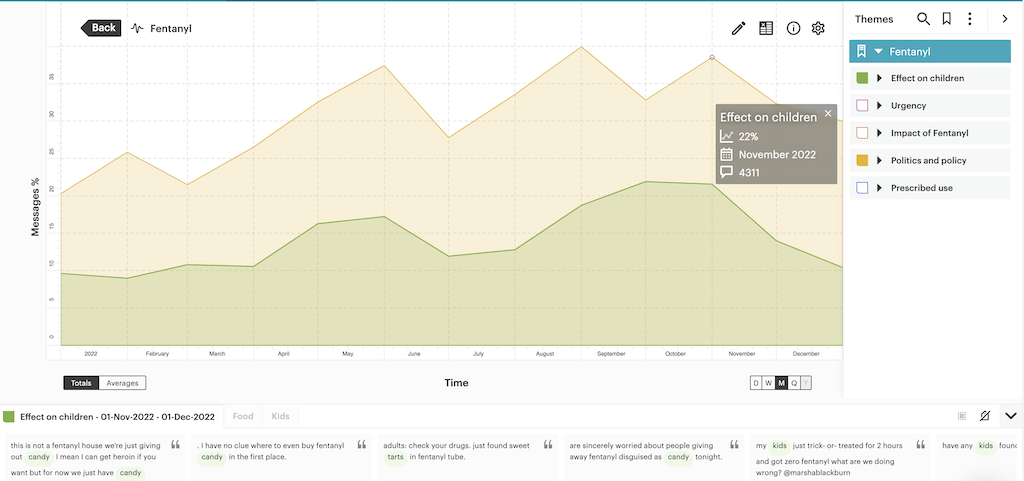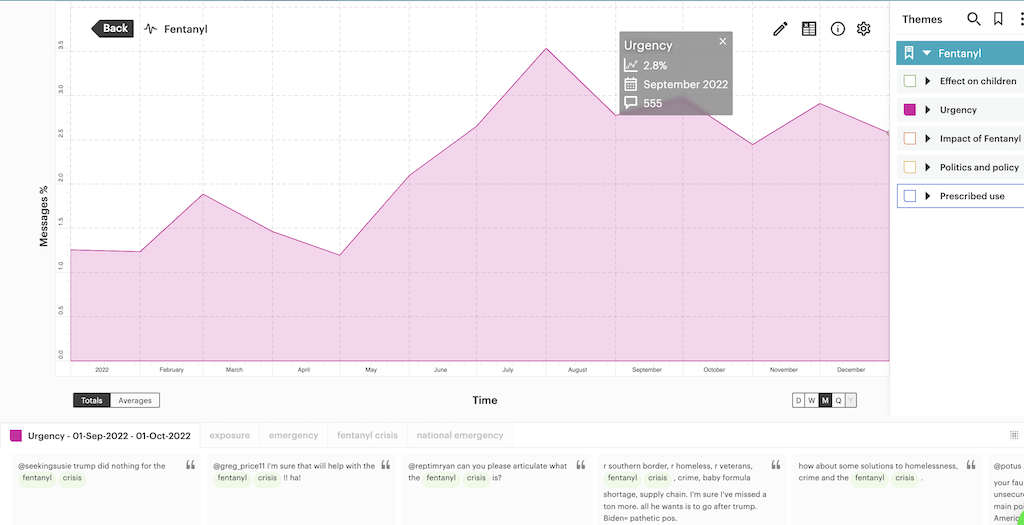Fentanyl’s evolution from a health issue to a political debate in 2022

Opioid challenges have existed in US society for at least 30 years. In 2022, fentanyl emerged as the opioid health issue which captured the public’s attention. We explore how social media conversations about the drug in America changed over the course of the year.
The super-strength painkiller can be prescribed by healthcare professionals, however, both addiction and accidental exposure has led it to become a key health problem in the community. Fentanyl has become one of the biggest health issues today after drug dealers began lacing other substances, such as heroin, cannabis and cocaine, with the painkiller.
The opioid is approximately 100 times stronger than morphine, meaning that it’s very easy to overdose on it. It’s this spike in fentanyl-related overdoses, often inadvertently through taking other drugs, that’s made it a topic of national conversation. But just how did that conversation evolve throughout the course of 2022?
To investigate the public’s reaction, we used a combination of social media analysis tools. We gathered Twitter conversations about fentanyl from US audiences through a social listening platform. This unstructured data amounted to over 5.2m words – impossible for a human to analyze efficiently and effectively.
Our social insights software can do both. We used a combination of Relative Insight Medical – our healthcare-specific tool – and Relative Insight Heartbeat to analyze and visualize how conversations changed throughout 2022. Relative Insight Medical successfully identified key medical-related topics and general themes from conversations about the drug. We then tracked these themes throughout the course of 2022 using Heartbeat.
What did we conclude? That increased awareness of fentanyl has turned it from a health issue into a political hot potato.
Fentanyl as a treatment
Despite its increasing notoriety as an overdose-inducing drug, tweeters still highlighted fentanyl’s purpose as pain relief medication at the beginning of 2022. Relative Insight Medical’s medical-specific processing pipeline enables it to interpret the specialist language of health more precisely. This allowed it to correctly categorize a myriad of medical-related topics, words and phrases related to fentanyl’s pain relieving properties, all of which over-indexed in tweets from the start of the year.
These health topics included ‘medical abbreviations’ (2.0x) – mostly ‘Rx’ for prescriptions – ‘general symptoms’ (1.5x) such as ‘pain’, ‘cellular disease & cancer’, (1.8x) and ‘chronic symptoms’ (1.4x). Discussions were also 1.4x more likely to talk about the logistics of prescription, such as ‘supply’ and ‘distribution’, with many tweeters highlighting the contrast in the illicit supply of the drug against difficulties getting pain relief medication from healthcare practitioners.
“Riddle me this: if we replaced all the illicit fentanyl out there that has no dosage & replaced it w/ fentanyl from a pharmacy, it would save lives. Rx for opioids decreased 50%, DEA reduced the opioid supply by 70 % in 6 yrs; ODs are the highest it’s ever been! Gl didn’t work!“
However, as fentanyl overdoses received greater attention, the health element took a backseat. To demonstrate this, we grouped the topics cited above into the theme of ‘prescribed use’, then created a visualization using Relative Insight Heartbeat. As the Heartbeat chart illustrates, discussion about the drug as a health issue is prevalent in the first few months of 2022, before decreasing sharply in April and continuing to fall in the following months.

April also marked a change in prevalence. From May onwards, the number of tweets about the drug almost doubled. This increase in frequency marked a shift in tone – tweeters went from treating fentanyl as a health issue to a political challenge.
Politicians urged to think of the children
As awareness of fentanyl overdoses increased, so did a focus on politics and policy. Tweeters were 1.6x more likely to talk about the topic of ‘politics’, using words like ‘vote’, “Dems’ and ‘Republicans’. They also commented on government policy more often. Tweets discussed the ‘border’ 1.4x more and contrasted action on fentanyl with policies on gun control – discussing ‘guns’ 1.7x more.
The Heartbeat chart demonstrates that increased awareness about fentanyl as a major health issue in the community led to conversation shifting – with tweeters highlighting who they thought was to blame and how the problem could be resolved.
“It’s just political theater from both sides. R’s need to impeach Biden 1st for allowing 1000s of Americans to be killed every month by fentanyl from our southern border. Both parties couldn’t care less. I’ve been independent since I could vote.“

Throughout the course of the year, the drug’s impact on children and young people became a bigger focus, peaking in fall. In the latter part of 2022, tweeters were 1.4x more likely to highlight children when discussing fentanyl. This followed a warning from the DEA that dealers were using brightly colored fentanyl to target young people. Nicknamed ‘fentanyl candy’, this led to conversations around ‘candy’ becoming 16.4x more prevalent.
Plotting the theme of the impact on children within a Heartbeat chart not only illustrates the change in conversation over time, it also reveals a fascinating correlation between conversations around the theme of politics and policy and impact on children. The public backlash at politicians is at its highest when the focus is on young people taking fentanyl. It’s when children and young adults are brought up that the public becomes even more agitated.
Tweeters want immediate action
The final interesting evolution in fentanyl conversations over the course of 2022 was an increase in the expression of urgency. As public awareness of fentanyl overdoses grew, tweeters began to use language intensifying the scale of the problem.
From May and beyond, they were 2.2x more likely use the word ’emergency’ and 11.4x more likely to describe fentanyl deaths as a ‘national emergency’. Social media conversations also used the phrase ‘fentanyl crisis’ 1.8x more in the latter part of 2022.
“Fentanyl overdoses become no.1 cause of death among US adults, aged 18-45. ‘A national emergency’, more adults between 18 and 45 died of fentanyl overdoses in 2020 than Covid-19, motor vehicle accidents, cancer and suicide.“

The Heartbeat chart visualizes that the public began to express greater urgency around fentanyl from May onwards, with the use of this type of language reaching a crescendo in July. While there are peaks and troughs throughout the remainder of the year, expressions of urgency are still far more prevalent than prior to May – demonstrating that the seriousness and scale of fentanyl overdoses has captured the public’s attention.
Using social analysis to visualize an evolving health issue
Through a combination of Relative Insight Medical and Relative Insight Heartbeat, we’ve analyzed and visualized the progression of public discourse about fentanyl overdoses over the course of a year.
Relative for Medical’s specialist medical lexicon identified tweeters’ focus on fentanyl as a treatment early in 2022. However, the platform also analyzes non-health specific language in the same way as Relative Insight Explore – enabling the detection of trends related to politics, children and urgency as discussions changed later in the year.
Once Relative Insight Medical identified these key themes, Relative Insight Heartbeat showcased to power of text data visualization. Not only did the tool illustrate how conversation changed from May and beyond, the Heartbeat chart showed the correlation between discussions about the drug’s impact on young people and conversations about policy and politics.
Not only does this example highlight how fentanyl has changed from a health issue to a political hot topic, it also demonstrates how using the right social analytics platform can help you interpret a range of health-related trends.
Find out more about how you can use Relative Insight Medical, Heartbeat or any other Relative Insight product to analyze and visualize text data by speaking to one of our team.
